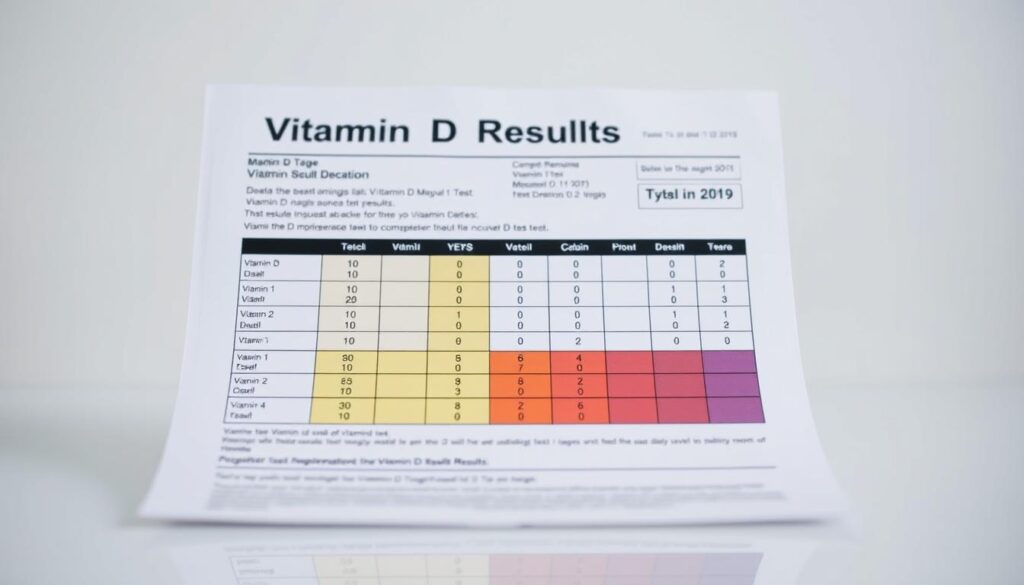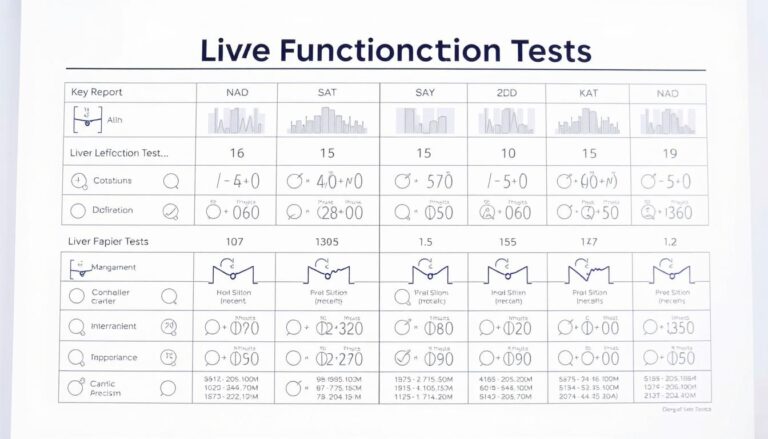Vitamin D Test Results: Understanding Your Levels
What does it mean to have optimal vitamin D levels? How can we understand our vitamin D test results to avoid deficiency? We’ll explore the importance of vitamin D blood tests and how to interpret them.
Vitamin D is key for bone health. Its deficiency can cause health issues. A blood test measures vitamin D levels. Knowing our results helps diagnose and treat deficiency, keeping our vitamin D levels in check.

Understanding our vitamin D test results helps prevent deficiency. We’ll look at different vitamin D tests, like the 25-hydroxy vitamin D test. The normal range is 20-40 ng/mL. This info helps us make healthy choices about our vitamin D levels.
What Is a Vitamin D Blood Test and Why We Need It
A vitamin D blood test checks the vitamin D levels in your blood. It’s key for spotting and fixing vitamin D deficiency. The test looks at 25-hydroxyvitamin D, the most common type. Knowing about vitamin d test values and lab results helps us understand the results and what’s normal.
Vitamin D tests are vital for finding and treating vitamin D deficiency. This deficiency can cause problems like osteoporosis and rickets. It’s important to know how to read vitamin d test results to help with treatment.
Types of Vitamin D Tests
There are two main vitamin D tests: the 25-hydroxyvitamin D test and the 1,25-dihydroxyvitamin D test. The 25-hydroxyvitamin D test is the most common. It checks the 25-hydroxyvitamin D levels in your blood.
Importance of Vitamin D Tests
Vitamin D tests are key for diagnosing and treating vitamin D deficiency. They help find out if someone’s vitamin D levels are normal or if they’re at risk of deficiency.
Recent studies show up to 40% of adults in the U.S. might not have enough vitamin D. This makes vitamin D tests very important for preventing and treating deficiency.
| Vitamin D Level | Description |
|---|---|
| 20-50 ng/mL | Optimal reference range for vitamin D levels |
| Below 20 ng/mL | Deficient vitamin D levels |
| 20-30 ng/mL | Insufficient vitamin D levels |
Understanding Vitamin D Test Results Range and Reference Values
It’s key to understand vitamin d test results. Knowing the normal range is important. The normal range for vitamin D levels is between 20-40 ng/mL. Levels below 20 ng/mL show a vitamin D deficiency. Levels above 40 ng/mL might be too high.
Always talk to a healthcare professional about your vitamin d blood test results. They can guide you based on your specific situation.
A vitamin d levels chart can help you see the ranges. For example, a level of 30-50 nmol/L (12-20 ng/mL) is not enough for bone health. Knowing your vitamin d levels is critical for diagnosing and treating deficiency.
| Age Group | Recommended Daily Amount | Normal Vitamin D Level |
|---|---|---|
| 0-12 months | 10 mcg (400 IU) | 20-40 ng/mL |
| 1-70 years | 15 mcg (600 IU) | 20-40 ng/mL |
| 71+ years | 20 mcg (800 IU) | 20-40 ng/mL |
How to Interpret Your Vitamin D Lab Results
Understanding your vitamin D lab results is key. The report shows your vitamin D levels in the blood. Your doctor will look at these levels against a standard range.
The best vitamin D range is between 20-50 ng/mL. Knowing this helps you understand your results better.
Signs of vitamin D deficiency include bone pain, muscle weakness, and feeling tired. If your levels are low, your doctor might suggest supplements or other treatments. High levels can also cause problems, so your doctor might advise reducing supplements.
It’s important to keep your vitamin D levels in the optimal range. This prevents severe effects of low levels.
Here are some key points to consider when interpreting your vitamin D lab results:
- Vitamin D deficiency levels: less than 20 ng/mL
- Suboptimal vitamin D levels: 20-29 ng/mL
- Optimal vitamin D range: 30-100 ng/mL
- High vitamin D levels: above 100 ng/mL
Talking to your doctor about your vitamin D levels is vital. They can guide you on what to do next. They’ll help you keep your levels in the optimal range and avoid the effects of low levels.
| Vitamin D Level | Classification | Recommendation |
|---|---|---|
| Less than 20 ng/mL | Deficient | Supplementation |
| 20-29 ng/mL | Suboptimal | Maintenance dose |
| 30-100 ng/mL | Optimal | No action needed |
| Above 100 ng/mL | High | Reduce supplementation |
Interpreting Vitamin D Blood Test Results
Understanding your vitamin D blood test results is key to maintaining your health. These results can tell you a lot about your vitamin D levels and whether you might have a deficiency. Here’s how to interpret your test results:
Normal Vitamin D Levels
Normal vitamin D levels are between 20-50 ng/mL. If your test shows a value within this range, it means your vitamin D levels are healthy. This is good news for your bones and overall health.
Vitamin D Deficiency
If your test shows a value below 20 ng/mL, it might mean you have a vitamin D deficiency. This can lead to weak bones and other health issues. It’s important to talk to your doctor about how to increase your vitamin D levels.
Vitamin D Toxicity
On the other hand, if your test shows a value above 50 ng/mL, it could indicate vitamin D toxicity. This is a serious condition that can cause problems like kidney stones and heart issues. Your doctor will guide you on how to manage this.
It’s important to remember that vitamin D levels can change over time. If you’re concerned about your levels, always talk to your doctor. They can help you understand your results and suggest the best course of action.
Here’s a quick reference chart to help you understand your vitamin D test results:
| Vitamin D Level (ng/mL) | Interpretation |
|---|---|
| 20-50 | Normal |
| Below 20 | Vitamin D Deficiency |
| Above 50 | Vitamin D Toxicity |
Remember, this chart is just a guide. Always consult with your doctor to get a full understanding of your vitamin D levels and any necessary actions.







